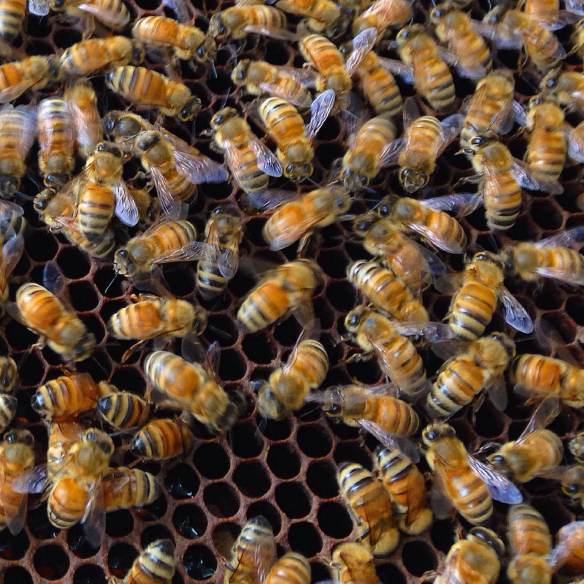Jonsey had been stung twice by the time I arrived at the apiary. “I put my head around the net and they got me,” he said, pulling on his suit. It was a hot and humid Sunday. We were taking off the honey, although the muggy air was the more likely reason for the bees’ defensive behaviour. Jonsey was helping out while Emily was away.
I had put a clearer board underneath a super in Myrtle’s hive on Saturday afternoon. A clearer board has one or two ‘escapes’ that let bees go down but not back up, so ‘clearing’ the super of bees. I took off the roof and saw that the clearer board had done the job. Jonsey carried the super to the apiary table where we brushed off stragglers and wrapped the box in plastic to prevent more bees, or wasps, from flying inside.
That was two weeks’ ago. Since then Emily and I have taken off a second super, both are sitting in my dad’s kitchen ready to spin the honey.
So what about the bees? Our favourite hive may be queenless. Myrtle mysteriously disappeared a month ago with strangely squashed queen cells found inside the hive. The workers are behaving calmly, not erratic like a queenless colony, but there is no sign of a new queen, eggs or much brood. We put a second test frame of eggs from Chili’s colony into the hive to see if the workers try to make queen cells.
Emily inspected Pepper’s hive and reported all was well, though the queen was in hiding. Queens Chili and Chamomile did make an appearance. Can you spot Chili in her queen cage? She has a pink crown.
Chamomile was hiding in a crevice underneath the comb where we couldn’t cage her. A few bees were crawling around with shrivelled wings, a sign of deformed wing virus (DWV) which can be transmitted to queens when they mate with infected drones. We also saw black shiny hairless bees who may have chronic bee paralysis virus (CBPV), which is thought to be transmitted by varroa. Soon we’ll be starting varroa treatments on the hives.
So that’s where we left our bees at the weekend with the honey harvested and the queens still keeping us guessing. Jonsey observed drones cowering in the corners of frames. The season is nearly over and they know what is to come…
Here’s a big beefy drone who fell in love with me. He sat on my yellow gloves during a recent inspection, fluttering his wings. I felt like a queen bee.





So exciting! I can’t wait for the honey update. I, too, will be treating my hives shortly.
I’m so excited to taste our honey, I’ll let you know what it’s like. Are you treating your hives with Apiguard?
Yeah Jonsey! This Jonsey got two hits from one bee through my shirt whilst weeding yesterday. Keep up with the Jonsey’s eh!
A sting through your shirt?! While weeding? Sure it wasn’t a wasp? 😉
Hundred percent. : )
Do you always wait before extracting? We find it MUCH easier to extract on the same day you remove the super. Honey has a nasty habit of crystalising quickly away from all those warm bee bodies which makes spinning really difficult and a lot of honey just won’t come out of the comb.
Even worse is that any uncapped nectar can ferment in a matter of days. Once we couldn’t extract for a week after removing some supers and we ended up with one frame of mead. Well, not quite but it was stinky and we had to shake it all out before we could extract the good honey – we didn’t want to contaminate the whole batch. And it was quite cool where we stored the frames so I know it can happen quickly.
I wait with bated breath for the post (here or by Emily) about the extraction! – And about your queenless hive. You’ll need to get a new queen in there soon if they haven’t been good little bees and made their own.
Ideally I’d extract same day but that hasn’t been possible this year. In my first year I had to wait weeks before extracting and the honey span out fine, while one year Emily and I extracted same day and the honey wouldn’t spin out at all. So it varies. Luckily it’s all capped this year so no risk of fermented nectar. Mostly we’re looking forward to tasting the honey!
Uh, how do queen cells get squashed without you knowing it? How much honey do you leave in the hive for the winter? Congratulations on getting some this year. It’s nice to have a little jar of honey when you want to give something nice to people.
That’s a good question… Emily and I have no idea, but we’ll have to move on from that piece of bad luck.
Advice on how much honey a hive needs for winter varies. The BBKA advise 20-30lb while other sources say 60-80lb and neither specify whether this is for single or double brood. We’ll be making a count of stores for each hive over coming weeks and making sure we are only extracting a surplus. It is nice to get some honey for family and friends, particularly that it’s from Myrtle’s hive.
I like the photograph of the drone. The eyes are really different. I think he’ll have a few more flowers he can visit yet. Amelia
I wondered if he was trying to tell me about Myrtle – that was the evening we were looking for her 😉 Drones are lovely but very noisy.
I am going to miss the mentions of Myrtle. I hope honey overflows in your hives.
Me too on both counts!
Does this mean honey cake? [is there such a thing? If not, there ought to be] RH
There is indeed honey cake RH, and honey cup cakes and many more honey-glazed recipes!